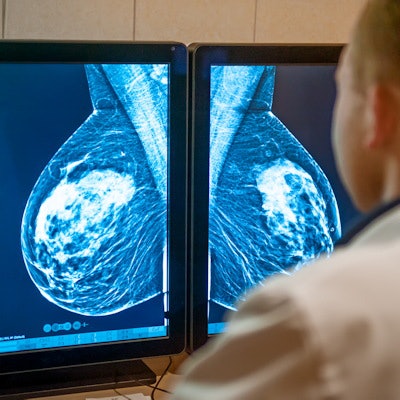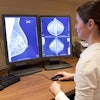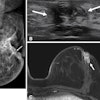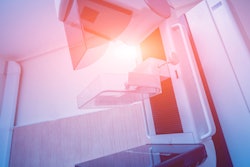
The COVID-19 pandemic has shown that switching from real-time to batch offline mammography exam interpretation lowers abnormal interpretation rates, according to research published December 7 in the Journal of the American College of Radiology.
A team led by Dr. Catherine Giess from Brigham and Women's Hospital in Boston found similar cancer detection rates and positive predictive values between offline and real-time breast cancer screening exam interpretation -- and reduced recall rates for offline screening compared to live screening, with the biggest differences seen among readers with higher abnormal interpretation rates in the live screening period.
"Efforts to reduce false positive recalls are an important area of research because false positives offer disadvantages to patients, imaging centers, insurers and the health care system, and are a common criticism of screening mammography programs," Giess and colleagues noted.
The pandemic presented challenges to breast imaging in that most centers were forced to temporarily close as healthcare resources were diverted to combat COVID-19. Following the reopening of breast imaging centers in the summer of 2020, radiologists were challenged to provide timely imaging services while minimizing patient waiting times. Giess et al wrote that their cancer center instituted offline batch screening interpretation for women for this reason.
The investigators sought to assess the impact on mammography screening metrics of batch offline screening interpretation versus live interpretation in a study that compared two periods: a live, immediate interpretation period (2018 to 2019) and an offline interpretation period (2020 to 2022); the authors compared screening metrics for 17 radiologists who interpreted during both periods.
In the live period, researchers reported 7,105 screenings, 635 recalls, and 51 screen-detected cancers. In the offline period, there were 7,512 screenings, 586 recalls, and 47 screen-detected cancers.
The team found significant differences in abnormal interpretation rates, cancer detection rates, and positive predictive value for both periods.
| Offline vs. live breast cancer screening interpretation | |||
| Measure | Live | Offline | p-values |
| Abnormal interpretation rate | 8.9% | 7.8% | 0.01 |
| Cancer detection rate | 7.2 per 1,000 | 6.3 per 1,000 | 0.5 |
| Positive predictive value | 8% | 8% | N/A |
When the researchers grouped radiologists by greater or less than 10% abnormal interpretation rates, those readers with a greater than 10% rate showed a significant decrease in abnormal interpretation rate for batch offline interpretation compared to live interpretation (9.7% vs. 12.7%, p < 0.001). No significant changes were seen in the group with abnormal interpretation rates of less than 10%, the team observed.
The findings suggest that offline batch interpretation not only improves radiologists' reading performance but also may lessen patient anxiety through timely delivery of results.
"Technology tools like the electronic health record can give same-day results to patients, alleviating anxiety," the group concluded. "A commitment to timely scheduling of needed diagnostic imaging would also reduce uncertainty and anxiety for ... patients."
They also highlighted that the reduced recall rates seen in this study could also reduce unnecessary diagnostic workups, additional radiation exposure, time and anxiety for women, and improve diagnostic imaging access for other patients.




















